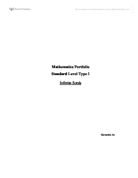a7: = 1.617851 ...
a8: = 1.617977 ...
a9: = 1.618016 ...
a10: = 1.618028 ...
From the first ten terms of the sequence you can see that the next sequence is
the previous term. Turning that into a formula for an+1 in terms of an makes:
From the plotted points of the infinite surd in graph 1, you can see that the greater n increases, the closer an gets to the value of about 1.61803. But an never touches that value; that causes the curve to flatten out. It also shows that the rise of the slope is continually decreasing as n increase. So as n gets larger, an- an+1 gets closer to 0. Since the sequence goes on forever, it cannot be determined if an- an+1 ever equals 0.
From previous results, you know that as n, an gets flatter and levels out right under about 1.61803. The value of the infinite surd which is about 1.61803 can be considered as x. So, let x be:
x =
(x)2 = 2 Square both sides to create an equation to work with.
x2 = The infinite surd continues.
x2 = 1+x Substitute with x since x =.
x2 -x-1 = 0 Equate to zero.
x = Use quadratic formula to solve for x.
x =
x =
x = Since a negative number cannot be square rooted, the negative exact value is an extraneous root because it doesn't work.
x = Only the positive value is accepted.
We can further our understanding of infinite surds by looking at this next example:
Like the first infinite surd, the first 10 terms of this infinite surd's sequence are also all irrational numbers.
a1: = 1.847759 ...
a2: = 1.961570 ...
a3: = 1.990369 ...
a4: = 1.997590 ...
a5: = 1.999397 ...
a6: = 1.999849 ...
a7: = 1.999984 ...
a8: = 1.999990 ...
a9: = 1.999997 ...
a10: = 1.999999 ...
From the first ten terms of the sequence you can see that the next sequence is
the previous term. Turning that into a formula for an+1 in terms of an makes:
The relationship shown from the plotted points of the infinite surd in graph 2 is that as n increases, the closer an gets to the value of about 2.000 but an will never pass that point. The graph also shows how the rise of the slope is continually decreasing as n increase. So as n gets larger, an- an+1 continues to decrease closer to 0. Just like the infinite surd from example 1, it cannot be determined if an- an+1 ever equals 0 because the sequence also goes on forever.
From graph 2, you know that as n, an gets flatter and levels out at about 2.0. The value of the infinite surd which is about 2.0 can be considered as x. So, let x be:
x =
(x)2 = 2 Square both sides to create an equation to work with.
x2 = The infinite surd continues.
x2 = 2+x Substitute with x since
x =.
x2 -x-2 = 0 Equate to zero.
x = Use quadratic formula to solve for x.
x =
x =
x =
x = Since a negative number cannot be square rooted, the negative exact value is an extraneous root because it doesn't work.
x =
x = 2 Only the positive value is accepted.
Now that two numerical examples of an infinite surd's exact value has been shown. Let us expand our understanding of the exact value of an infinite surd by looking at the following general infinite surd:
From graph 1 and graph 2 it is shown that an infinite surd's slope becomes flatter as the number of terms increases. Just like before, you can represent this whole infinite surd with:
x =
(x)2 = 2 Square both sides to create an equation to work with.
x2 = The infinite surd continues.
x2 = k + x Substitute with x since
x =.
x2 - x - k = 0 Equate to zero.
x = Use quadratic formula to solve for x.
x =
x = Since a negative number cannot be square rooted, the negative exact value is an extraneous root because it doesn't work.
x = Only the positive value is accepted.
As shown in Discovery 2b page 9, an infinite surd can be an integer. Since represents the general exact form for all infinite surds, we can throw in values for k to find values that make the expression an integer.
From this it is shown that = N2, from this we want to again solve for k to see what value k can be.
Since k is always an even number as seen in Example 4, must be an even number because an even number divided an even number still makes an even number(k). So:
= an even number.
= an odd number.
= an odd number because the square root of an odd number always equals an odd number.
a is any even natural number because the product of any number multiplied with an even number is even, and b is any natural number.
substitute a with 2 since it is the lowest even natural number.
Now that we know what is, we can substitute into making:
k =
k =
k =
k =
k =
To prove that k = , will give an integral value, we can substitute k = into .
The limitation to the general statement of the infinite surd being expressed is an integral value is that in k = , b must be any positive integral value equal or above zero. As shown in Example 4a, if b is a rational number, then equals a rational number.
As we have seen from Examples 1 and 2, infinite surds do not increase forever, their curve actually levels out as the terms in the infinite surd increases. We also saw that in the sequence of an infinite surd, the next term is the square root of the numerical value in the surd added with the previous term in the sequence. From Example 3, we learned that the general form for the exact value of all infinite surds is and Example 4 showed that the exact value can be an integer if k = . In Example 4 we also learned that b = because if b were a rational number, the exact value of the infinite surd would not be integral.
References:
Table of mathematical symbols. Retrieved April 25, 2009, from
Wikipedia Web site:
http://en.wikipedia.org/wiki/Table_of_mathematical_symbols
(2008, August 25). Infinite surds - expression for which the exact value is
an integer . Retrieved April 25, 2009, from Math Forum Help
Web site: http://www.mathhelpforum.com/math-help/other-
topics/46681-infinite-surds-expression-exact-value-integer.html
How do i find the exact value for an infinite surd?. Retrieved April 25, 2009, from Yahoo Answers Web site: http://answers.yahoo.com/question/index;_ylt=Au.kibwg0umFF6o1yLGdENcjzKIX;_ylv=3?qid= 20090117014917AAnvdJz
2009, March 12). Various questions about surds . Retrieved April 25,
2009, from Math Help Forum Web site:
http://www.mathhelpforum.com/math-help/other-topics/46681-
infinite-surds-expression-exact-value-integer.html
(2009, February 23). Infinite Surds . Retrieved April 16, 2009, from http://thewonderfulworldofmath.blogspot.com/2009/02/infinite-surds.html
M (2009, February 18). Mathematics Sl Portfolio Infinite Surds.
Retrieved April 25, 2009, from Anti Essays Web site:
http://www.antiessays.com/free-essays/34605.html
tmgt5, "[Math SL] Infinite surds, All questions concerning this
project ." IB Survival. 13 April 2009. 26 Apr 2009
<http://www.ibsurvival.com/forum/index.php?
showtopic=2347>.
Suomalainen, Heikki . "INFINITE SURDS." 23 May 2008. 26
Apr 2009 <www.lyseo.edu.ouka.fi/~hequel/portfolio.doc >.







